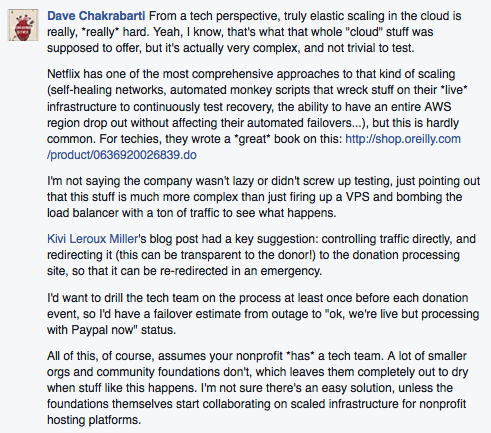
Jay Love
Online days of giving like Giving Tuesday, Brackets for Good, and Give Local America have become wonderful fundraising tools for nonprofits of every shape and size.
For some small charities without large marketing budgets, these online events have become critical tools for funding their mission.
However, the recent controversy surrounding May’s Give Local America campaign has cast a shadow on an otherwise positive aspect of the fundraising ecosystem.
Now that the dust has somewhat settled, I wanted to share a few thoughts on the episode that I hope will be helpful to both those observing from afar and those right in the thick of things.
Catastrophes Can and Will Happen
The sad truth is that as long as human beings are in charge of creating and administering the technology that nonprofits rely on for online giving, donor management, website hosting, email deliverability and similar tools, the possibility of a failure will always be there.
An expectation of 100% uptime is naive, and any vendor claiming it should be met with extreme skepticism.
This isn’t to say that a vendor can’t espouse high reliability, and current and prospective customers should inquire into a vendor’s past performance on prior heavy traffic/giving days.
But the realistic view that crashes can happen underscores the need for nonprofits to diversify their fundraising efforts, while at the same time taking practical steps to protect themselves during critical, high-volume periods.
It would be easy for me, the CEO of a tech company that serves the nonprofit sector, to score quick points by pointing the finger at competitors, quasi-competitors and other vendors like Kimbia when their tech goes down – but there isn’t a single vendor (in any sector) who hasn’t experienced an outage.
If you were hoping for a torch and pitchfork from me, I’m sorry to disappoint. I hope you won’t think that I’m merely showing camaraderie to a similar vendor by giving them a pass. Hard questions should be asked, and how those at fault deal with the issue, communicate outages, etc. is what should be judged the most. For now, I’ll leave that to those who were personally impacted.
Protect Yourself
There’s always an urge to blame the victim during episodes like these.
“What did they expect with all that traffic?”
“Why weren’t they using custom shortlinks or bit.ly?”
“Why didn’t they have a backup plan?”
Nonprofits rely on and trust providers to share best practices for the types of services they provide, and it’s not fair for those whose campaigns were cut short to shoulder any blame for a tech crash.
At the same time, many (including myself) have concerns over a growing reliance (some might say ‘addiction’) towards single-day or single-campaign fundraising, especially when third-party tech is involved. Far too often we put ourselves in a position to be victimized (see also: any time Facebook changes their algorithm).
While we see modest annual gains in overall giving, sector retention rates continue to stagnate. Rather than putting all of our eggs in one basket as so many do (a gala, an online day of giving, a holiday appeal, etc.), what would the impact be of a continuous, donor-centered focus on stewardship? How can we get off the acquisition treadmill?
Lastly, charities can and should do a bit of planning themselves for times of crisis.
Ask yourself: what will we do if our tech goes down?
A simple crisis communication plan (covering all sorts of issues, including mismanagement, fraud, abuse, etc.) is the cornerstone of an effective communications toolkit. This post from Dana Rinderknect outlines an excellent crisis planning methodology where every low, medium and high risk is identified. For the medium and high ones, alternative plans are created and in place to use.
What About the Community Foundations?
One party that seems to have avoided a lion’s share of criticism is the community foundations, who in most cases were the primary driver of nonprofit participation in the recent Give Local America campaign.
Many nonprofits have been slow to question their sponsoring foundations for fear of retribution. It’s always tough to criticize anything a funder is connected to.
Perhaps those foundations should have been more vigilant or diversified beyond only one online giving vendor. Were not the small-to-medium-sized charities counting on them to too?
We all know that our disappointments often build much more character than our achievements. Hopefully, this situation will provide the incentive for better planning, communication, and oversight going forward. If so, our sector as whole will be much better off.
Jay B. Love is CEO and Co-Founder of Bloomerang. He is current Chairman of the AFP Ethics Committee and was the Founding Chairman of NPower Indiana, Founding Member of TechPoint Foundation, Founding Member of the AFP Business Member Council and the Co-Founder of Launch Cause.







